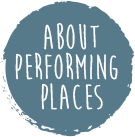


Background to the Performing Places website
This website is for arts practitioners working in communities and interested in exploring ‘place’ as a focus for workshops or performance work.
It arises from a research project funded by the Arts and Humanities Research Council (AHRC) called ‘Challenging concepts of “liquid” place through performance practices in community contexts’: www.challengingplace.org. From 2011 – 2014, researchers from Royal Central School of Speech and Drama, University of London (Professor Sally Mackey) and Aberystwyth University (Margaret Ames and Professor Mike Pearson) worked with three community arts organisations:
- Cyrff Ystwyth, Aberystwyth, a disabled and non-disabled performance company. This project was led by Margaret Ames and Mike Pearson worked with this project. Participants in the project were members of Cyrff Ystwyth, some of them longstanding members.
- Half Moon Theatre, London, a professional and participatory organisation for young people. This project was led by Vishni Velada Bilson and Samantha Adams. (Sally Mackey worked with this project.) Participants in the project were members of the ‘senior’ youth theatre.
- Oldham Theatre Workshop, a community theatre organisation within Oldham Council, Greater Manchester. This project was led by James Atherton and Craig Harris. (Sally Mackey worked with this project.) Participants in the project were drop-in migrants residing in Oldham at the time.
The work asked whether performance-related practices could ease or enhance personal feelings about local place. In an age of unwelcome rootedness as well as extensive movement and dislocation, we found such active engagement can make a difference to people’s lives.
The website offers facilitators a resource for work with performance, people and place.
See Place Theory for some further thinking about performance and place.
See Place People for details of the key people involved in the Challenging Place project.
See Pre-projects for some information about setting up the projects in Challenging Place.
Click here to view the video of the launch symposium of the Performing Places website, and some of the work attributed to it post-symposium.
How to navigate
There are several ways of accessing the examples of practices that may be useful.
- Enter Place Practices and start ‘at the beginning’ by looking at the clips in the following
order. (You may want to view Pre-Project Planning first.)
- Openers
- In the Studio and On Sites
- Sharing and ...
- The ‘Outline of Place Practices’ pdf for a summary of sessions. - Read the Outline of Place Practices pdf first and then access relevant examples of clips and writing.
- Follow one organisation’s Place Practices using the colour coding which runs throughout this section of the site. Oldham Theatre Workshop are in red, Half Moon in peach and Cyrff Ystwyth, green.
- Other Places can be viewed at any point. It offers a range of links to other work concerning participants, place and performance. It houses the acknowledgements also.
What will you see?
Each section of Place Practices has clips and accompanying writing. These examples of practice are offered as a resource and it is anticipated that practitioners will find them useful to inspire their own ideas for work of this nature. The practices shared here represent a selection of the work that took place. Because of the different nature of the individual projects, the type and amount of clips vary. There were more relevant ‘Openers’ for Oldham Theatre Workshop than there were for Cyrff Ystwyth, for example.
Whilst divided up to make the work accessible and aid navigation through the practices, clips are not always easily segregated into Openers, In the Studio or On Sites. There are crossovers, of course. In addition, each project worked within its own style and the clips reflect this. OTW used a number of individual exercises, for example, whereas the work of CY was mainly ongoing and fluid.
Written summaries accompany each clip and offer a perspective on how and why each exercise or practice was adopted. For CY, these are longer summaries because they frequently incorporate a form of translation from Welsh to English.
Outline of Place Practices pdf offers a downloadable and usable plan based on the examples offered in the Place Practices section.
